Formulation of Environmentally Safe Graffiti Remover Containing Esterified Plant Oils and Sugar Surfactant
Abstract
:1. Introduction
2. Results
2.1. Green Solvents as Esterified Natural Oil or Used Cooking Oil with PEG 400
2.2. Formulation of Eco-Friendly Graffiti Removers
2.3. The Speed of Runoff Eco-Friendly Graffiti Removers from Surface
2.4. The Effectiveness of Removing Graffiti Paints from the Flat Surface
2.5. Optimization of the Graffiti Remover Formulation
2.6. Attenuated Total Reflection—Fourier-Transform Infrared Spectroscopy (ATR FT-IR) Analysis
3. Discussion
4. Materials and Methods
4.1. Materials
4.2. Preparation of Esterified Natural Oil or Used Cooking Oil with PEG 400
4.2.1. Purification of Used Cooking Oil
4.2.2. Synthesis of Esterified Natural Oil or Used Cooking Oil with PEG 400 (Oil PEG-8 Ester Solvent)
4.3. Preparation of Eco-Friendly Graffiti Remover Formulations
4.4. The Speed of Runoff Graffiti Remover from Surface
4.5. The Effectiveness Removing Graffiti Paints from the Flat Surface
4.6. Laboratory Cleaning Evaluation
4.7. Attenuated Total Reflection—Fourier-Transform Infrared Spectroscopy (ATR-FTIR) Analysis
4.8. Optimization of the Studied Safe Graffiti Remover Formulation by RSM
5. Conclusions
Supplementary Materials
Author Contributions
Funding
Institutional Review Board Statement
Informed Consent Statement
Data Availability Statement
Conflicts of Interest
Sample Availability
References
- Nowotny, T.K.; Velinsky, S.A.; Lasky, T.A.; Donohoe, S.P. Test Driven Design of a System for Removing Graffiti from Retroreflective Signs. Mech. Based Des. Struct. Mach. 2012, 40, 366–379. [Google Scholar] [CrossRef]
- Baglioni, M.; Poggi, G.; Giorgi, R.; Rivella, P.; Ogura, T.; Baglioni, P. Selective removal of over-paintings from “Street Art” using an environmentally friendly nanostructured fluid loaded in highly retentive hydrogels. J. Colloid Interface Sci. 2021, 595, 187–201. [Google Scholar] [CrossRef] [PubMed]
- Ricci, C.; Gambino, F.; Nervo, M.; Piccirillo, A.; Scarcella, A.; Zenucchini, F.; Pozo-Antonio, J.S. Enhancement of graffiti removal from heritage stone by combining laser ablation and application of a solvent mixture. Constr. Build. Mater. 2020, 262, 119934. [Google Scholar] [CrossRef]
- Cortea, I.M.; Ratoiu, L.; Radvan, R. Characterization of spray paints used in street art graffiti by a non-destructive multi analytical approach. Color. Res. Appl. 2021, 46, 183–194. [Google Scholar] [CrossRef]
- Scheerder, J.; Visscher, N.; Nabuurs, T.; Overbeek, A. Novel, water-based fluorinated polymers with excellent antigraffiti properties. J. Coat. Technol. Res. 2005, 2, 617–625. [Google Scholar] [CrossRef]
- Gomes, V.; Dionísio, A.; Pozo-Antonio, J.S. Conservation strategies against graffiti vandalism on Cultural Heritage stones: Protective coatings and cleaning methods. Prog. Org. Coat. 2017, 113, 90–109. [Google Scholar] [CrossRef]
- Sanmartín, P.; Cappitelli, F.; Mitchell, R. Current methods of graffiti removal: A review. Constr. Build. Mater. 2014, 71, 363–374. [Google Scholar] [CrossRef]
- Whitford, M.J.; Ashworth, G.W. Getting Rid of Graffiti: A Practical Guide to Graffiti Removal and Anti-Graffiti Protection, 1st ed.; Taylor & Francis: London, UK, 1992. [Google Scholar]
- Sanmartín, P.; Mitchell, R.; Cappitelli, F. Evaluation of cleaning methods for graffiti removal. In Urban Pollution and Changes to Materials and Building Surfaces; Brimblecombe, P., Ed.; Imperial College Press: London, UK, 2016; pp. 291–312. [Google Scholar]
- Pozo-Antonio, J.S.; Rivas, T.; Fiorucci, M.P.; López, A.J.; Ramil, A. Effectiveness and harmfulness evaluation of graffiti cleaning by mechanical, chemical and laser procedures on granite. Microchem. J. 2016, 125, 1–9. [Google Scholar] [CrossRef]
- Carvalhão, M.; Dionísio, A. Evaluation of mechanical soft-abrasive blasting and chemical cleaning methods on alkyd-paint graffiti made on calcareous stones. J. Cult. Herit. 2015, 16, 579–590. [Google Scholar] [CrossRef]
- Cattò, C.; Sanmartín, P.; Gulotta, D.; Troiano, F.; Cappitelli, F. Bioremoval of graffiti using novel commercial strains of bacteria. Sci. Total Environ. 2021, 756, 144075. [Google Scholar] [CrossRef]
- Ortiz, P.; Antúnez, V.; Ortiz, R.; Martín, J.M.; Gómez, M.A.; Hortal, A.R.; Martínez Haya, B. Comparative study of pulsed laser cleaning applied to weathered marble surfaces. Appl. Surf. Sci. 2013, 283, 193–201. [Google Scholar] [CrossRef]
- Samolik, S.; Walczak, M.; Plotek, M.; Sarzynski, A.; Pluska, I.; Marczak, J. Investigation into the removal of graffiti on mineral supports: Comparison of nano-second Nd:YAG laser cleaning with traditional mechanical and chemical methods. Stud. Conserv. 2015, 60, 58–64. [Google Scholar] [CrossRef] [Green Version]
- Vasilache, V.; Sandu, I.C.A.; Pruteanu, S.; Caldeira, A.T.; Simionescu, A.E.; Sandu, I. Testing the cleaning effectiveness of new ecological aqueous dispersions applied on old icons. Appl. Surf. Sci. 2016, 367, 70–79. [Google Scholar] [CrossRef]
- Weaver, M.E. Removing Graffiti from Historic Masonry; National Park Service–U.S. Department of the Interior: Washington, DC, USA, 1995. Available online: https://www.nps.gov/tps/how-to-preserve/briefs/38-remove-graffiti.htm (accessed on 11 June 2021).
- Langworth, S.; Anundi, H.; Friis, L.; Johanson, G.; Lind, M.L.; Söderman, E.; Åkesson, B.A. Acute health effects common during graffiti removal. Int. Arch. Occup. Environ. Health 2001, 74, 213–218. [Google Scholar] [CrossRef] [PubMed]
- Crinnion, W.J. The CDC fourth national report on human exposure to environmental chemicals: What it tells us about our toxic burden and how it assist environmental medicine physicians. Altern. Med. Rev. 2010, 15, 101–109. [Google Scholar]
- Byrne, F.P.; Jin, S.; Paggiola, G.; Petchey, T.H.M.; Clark, J.H.; Farmer, T.J.; Hunt, A.; McElroy, C.R.; Sherwood, J. Tools and techniques for solvent selection: Green solvent selection guides. Sustain. Chem. Process. 2016, 4, 2–24. [Google Scholar] [CrossRef] [Green Version]
- De Jesus, S.S.; Filho, R.M. Recent advances in lipid extraction using green solvents. Renew. Sustain. Energy Rev. 2020, 133, 110289. [Google Scholar] [CrossRef]
- Claux, O.; Santerre, C.; Abert-Vian, M.; Touboul, D.; Vallet, N.; Chemat, F. Alternative and sustainable solvents for green analytical chemistry. Curr. Opin. Green Sustain. 2021, 31, 100510. [Google Scholar] [CrossRef]
- Cherubini, F. The biorefinery concept: Using biomass instead of oil for producing energy and chemicals. Energy Convers. Manag. 2010, 51, 1412–1421. [Google Scholar] [CrossRef]
- Maity, S.K. Opportunities, recent trends and challenges of integrated biorefinery: Part I. Renew. Sustain. Energy Rev. 2015, 43, 1427–1445. [Google Scholar] [CrossRef] [Green Version]
- Moncada, B.J.; Aristizabal, M.V.; Carlos, A.; Cardona, A.C.A. Design strategies for sustainable biorefineries. Biochem. Eng. J. 2016, 116, 122–134. [Google Scholar] [CrossRef]
- Capello, C.; Fischer, U.; Hungerbühler, K. What is a green solvent? A comprehensive framework for the environmental assessment of solvents. Green Chem. 2007, 9, 927–934. [Google Scholar] [CrossRef]
- Alfonsi, K.; Colberg, J.; Dunn, P.J.; Fevig, T.; Jennings, S.; Johnson, T.A.; Kleine, H.P.; Knight, C.; Nagy, M.A.; Perry, D.A.; et al. Green chemistry tools to influence a medicinal chemistry and research chemistry based organization. Green Chem. 2008, 10, 31–36. [Google Scholar] [CrossRef]
- Rocha e Silva, N.M.P.; Almeida, F.C.G.; Rocha e Silva, F.C.P.; Luna, J.M.; Sarubbo, L.A. Formulation of a Biodegradable Detergent for Cleaning Oily Residues Generated during Industrial Processes. J. Surfactants Deterg. 2020, 23, 1111–1123. [Google Scholar] [CrossRef]
- Giorgi, R.; Baglioni, M.; Baglioni, P. Nanofluids and chemical highly retentive hydrogels for controlled and selective removal of overpaintings and undesired graffiti from street art. Anal. Bioanal. Chem. 2017, 409, 3707–3712. [Google Scholar] [CrossRef] [Green Version]
- Ricci, C.; Gambino, F.; Nervo, M.; Piccirillo, A.; Scarcella, A.; Zenucchini, F.; Pozo-Antonio, J.S. Developing New Cleaning Strategies of Cultural Heritage Stones: Are Synergistic Combinations of a Low-Toxic Solvent Ternary Mixtures Followed by Laser the Solution? Coatings 2020, 10, 466. [Google Scholar] [CrossRef]
- Claesson, M.; Kjellin, U.R.M. Sugar surfactants. In Encyclopaedia of Surface and Colloid Science; Marcel Dekker: New York, NY, USA, 2002; pp. 4909–4925. [Google Scholar]
- Baglioni, P.; Chelazzi, D.; Giorgi, R.; Poggi, G. Colloid and Materials Science for the Conservation of Cultural Heritage: Cleaning, Consolidation, and Deacidification. Langmuir 2013, 29, 5110–5122. [Google Scholar] [CrossRef] [PubMed]
- Krawczyk, J. Solid Wettability Modification via Adsorption of Antimicrobial Sucrose Fatty Acid Esters and Some Other Sugar-Based Surfactants. Molecules 2018, 23, 1597. [Google Scholar] [CrossRef] [PubMed] [Green Version]
- Montis, C.; Koynov, K.; Best, A.; Baglioni, M.; Butt, H.-J.; Berti, D.; Baglioni, P. Surfactants Mediate the Dewetting of Acrylic Polymer Films Commonly Applied to Works of Art. ACS Appl. Mater. Interfaces 2019, 11, 27288–27296. [Google Scholar] [CrossRef]
- Liu, X.; Tian, J.; Li, Y.; Sun, N.; Mi, S.; Xie, Y.; Chen, Z. Enhanced dyes adsorption from wastewater via Fe3O4 nanoparticles functionalized activated carbon. J. Hazard. Mater. 2019, 373, 397–407. [Google Scholar] [CrossRef]
- Rocher, V.; Siaugue, J.-M.; Cabuil, V.; Bee, A. Removal of organic dyes by magnetic alignate beads. Water Res. 2008, 42, 1290–1298. [Google Scholar] [CrossRef] [PubMed]
- Balicki, S.; Pawlaczyk-Graja, I.; Gancarz, R.; Capek, P.; Wilk, K.A. Optimization of Ultra-sound-Assisted Extraction of Functional Food Fiber from Canadian Horseweed (Erigeron canadensis L.). ACS Omega 2020, 5, 20854–20862. [Google Scholar] [CrossRef] [PubMed]
- Balicki, S. Unit process optimization in the organic technology. Przemysł Chem. 2021, 100, 490–497. [Google Scholar]
- Kamairudin, N.; Gani, S.S.A.; Masoumi, H.R.F.; Hashim, P. Optimization of Natural Lipstick Formulation Based on Pitaya (Hylocereus polyrhizus) Seed Oil Using d-optimal Mixture Experimental Design. Molecules 2014, 19, 16672–16683. [Google Scholar] [CrossRef] [PubMed] [Green Version]
- Schreiner, T.B.; Santamaria-Echart, A.; Ribeiro, A.; Peres, A.M.; Dias, M.M.; Pinho, S.P.; Barreiro, M.F. Formulation and Optimization of Nanoemulsions Using the Natural Surfactant Saponin from Quillaja Bark. Molecules 2020, 25, 1538. [Google Scholar] [CrossRef] [PubMed] [Green Version]
- Ochoa, D.H.; Braga, J.W.B.; Machado, F. Optimization of the Functional Characteristics of Cleaning Products through Experimental Design. J. Surfac. Deterg. 2017, 20, 467–481. [Google Scholar] [CrossRef]
- Xuebin, W.; Jincheng, W. Studies on the preparation and properties of biodegradable polyester from soybean oil. Green Process. Synth. 2019, 8, 1–7. [Google Scholar] [CrossRef]
- Naz, S.; Hussain Sherazi, S.T.; Talpur, F.N.; Kara, H.; Uddin, S.; Khaskheli, R. Chemical Characterization of Canola and Sunflower Oil Deodorizer Distillates. Pol. J. Food Nutr. Sci. 2014, 64, 115–120. [Google Scholar] [CrossRef] [Green Version]
- Phan, A.N.; Phan, T.M. Biodiesel production from waste cooking oils. Fuel 2008, 87, 3490–3496. [Google Scholar] [CrossRef]
- Feng, G.Z.; Qu, H.; Cui, Y.; Li, H.P.; Lu, K. Synthesis and Kinetic Studies on Dimer Fatty Acid/Polyethylene Glycol Polyester. J. Polym. Res. 2007, 14, 115–119. [Google Scholar] [CrossRef]
- Ivanković, A.; Dronjić, A.; Martinović Bevanda, A.; Talić, S. Review of 12 Principles of Green Chemistry in Practice. Int. J. Sustain. Green Energy 2017, 6, 39–48. [Google Scholar] [CrossRef] [Green Version]
- Cardenas, J.; Orjuela, A.; Sanchez, D.L.; Narvaez, P.C.; Katryniok, B.; Clark, J.H. Pre-treatment of used cooking oils for the production of green chemicals: A review. J. Clean. Prod. 2021, 289, 125–129. [Google Scholar] [CrossRef]
- Della Volpe, C.; Penati, A.; Peruzzi, R.; Siboni, S.; Toniolo, L.; Colombo, C. The combined effect of roughness and heterogeneity on contact angles: The case of polymer coating for stone protection. J. Adhes. Sci. Technol. 2000, 14, 273–299. [Google Scholar] [CrossRef]
- Nowotny, T.K.; Velinsky, S.A. Assessment of Graffiti Removal Practices and Initial Development of a Tool for Removing Graffiti from Retroreflective Signs; Final Report: IA 65A0275, Task ID: 1955; Advanced Highway Maintenance and Construction Technology Research Center, University of California: Davis, CA, USA, 2009. [Google Scholar]
- Sa Silva, B.; Kupski, L.; Badiale-Furlong, E. Central Composite Design-Desirability Function Approach for Optimum Ultrasound-Assisted Extraction of Daidzein and Genistein from Soybean and Their Antimycotoxigenic Potential. Food Anal. Methods 2019, 12, 258–270. [Google Scholar] [CrossRef]
- Kua, Y.L.; Gan, S.; Morris, A.; Ng, H.K. Ethyl lactate as a potential green solvent to extract hydrophilic (polar) and lipophilic (non-polar) phytonutrients simultaneously from fruit and vegetable by-products. Sustain. Chem. Pharm. 2016, 4, 21–31. [Google Scholar] [CrossRef]
- Pereira, C.S.M.; Silva, V.M.T.M.; Rodrigues, A.E. Ethyl lactate as a solvent: Properties, applications and production processes-A review. Green Chem. 2011, 13, 2658–2671. [Google Scholar] [CrossRef]
- Foteinis, S.; Chatzisymeon, E.; Litinas, A.; Tsoutsos, T. Used-cooking-oil biodiesel: Life cycle assessment and comparison with first- and third-generation biofuel. Renew. Energy 2020, 153, 588–600. [Google Scholar] [CrossRef]
- Maliszewska, I.; Wilk, K.A.; Burczyk, B.; Syper, L. Antimicrobial Activity and Biodegradability of N-alkylaldonamides. Progr. Colloid Polym. Sci. 2001, 118, 172–176. [Google Scholar]
- Baglioni, M.; Costanza, M.; Chelazzi, D.; Giorgi, R.; Berti, D.; Baglioni, P. Polymer Film Dewetting by Water/Surfactant/Good-Solvent Mixtures: A Mechanistic Insight and Its Implications for the Conservation of Cultural Heritage. Angew. Chem. Int. Ed. 2018, 57, 7355–7359. [Google Scholar] [CrossRef]
- Carnero Ruiz, C. Sugar-Based Surfactants: Fundamentals and Applications; Taylor & Francis Group: Boca Raton, FL, USA, 2008. [Google Scholar]
- Wilk, K.A.; Syper, L.; Burczyk, B.; Maliszewska, I.; Jon, M.; Domagalska, B.W. Preparation and Properties of New Lactose–Derived Surfactants. J. Surf. Deterg. 2001, 4, 155–161. [Google Scholar] [CrossRef]
- Komorek, U.; Wilk, K.A. Surface and Micellar Properties of New Nonionic Gemini Aldonamide-Type Surfactants. J. Colloid Interface Sci. 2004, 271, 206. [Google Scholar] [CrossRef] [PubMed]
- Wilk, K.A.; Zielińska, K.; Jezierski, A. Structural aspects in saccharide-derived micelles studied by a spin probe technique. Colloids Surf. A 2009, 343, 64–69. [Google Scholar]
- Burczyk, B.; Wilk, K.A.; Sokołowski, A.; Syper, L. Synthesis and Surface Properties of N–Alkyl–N–methylgluconamides and N–Alkyl-N–methyllactobionamides. J. Colloid Interface Sci. 2001, 240, 552–558. [Google Scholar] [CrossRef]
- Carretti, E.; Giorgi, R.; Berti, D.; Baglioni, P. Oil-in-water nanocontainers as low environmental impact cleaning tools for works of art: Two case studies. Langmuir 2007, 23, 6396–6403. [Google Scholar] [CrossRef]
- Rousta, L.K.; Yazdi, A.P.G.; Amini, M. Optimization of athletic pasta formulation by D-optimal mixture design. Food Sci. Nutr. 2020, 8, 4546–4554. [Google Scholar] [CrossRef]
- Bartman, M.; Szczepaniak, P.; Wesołowska-Piętak, A.; Bańkowski, B. The Method for the Preparation of Low and/or Medium Molecular Weight Polymeric Surfactants with a Defined Hydrophilic-Lipophilic Balance. Patent WO2019098865A1, 23 May 2019. [Google Scholar]
- Sanmartín, P.; Cappitelli, F. Evaluation of Accelerated Ageing Tests for Metallic and Non-Metallic Graffiti Paints Applied to Stone. Coatings 2007, 7, 180. [Google Scholar] [CrossRef] [Green Version]
- Musolino, M.; Aricò, F.; Tundo, P. An innovative and sustainable approach to spray paint graffiti removal from Istrian stone through the silica sol-gel chemistry: A preliminary assessment. J. Cult. Herit. 2018, 36, 268–274. [Google Scholar] [CrossRef]
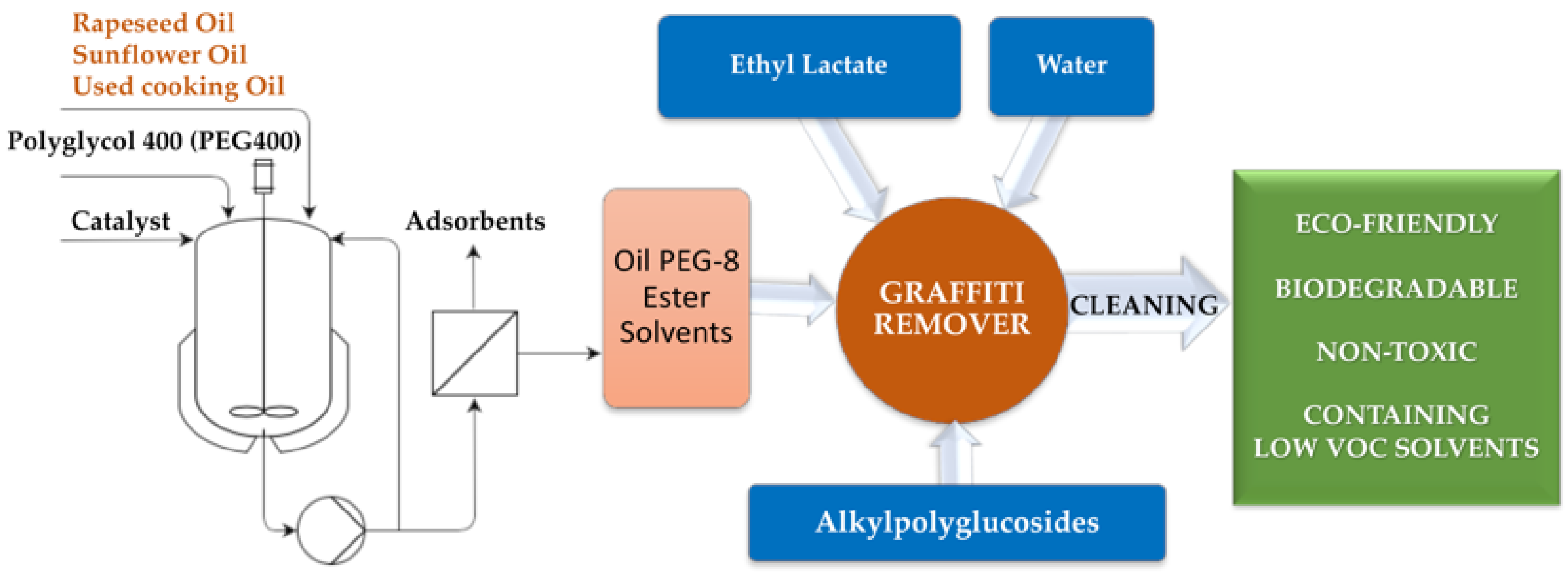
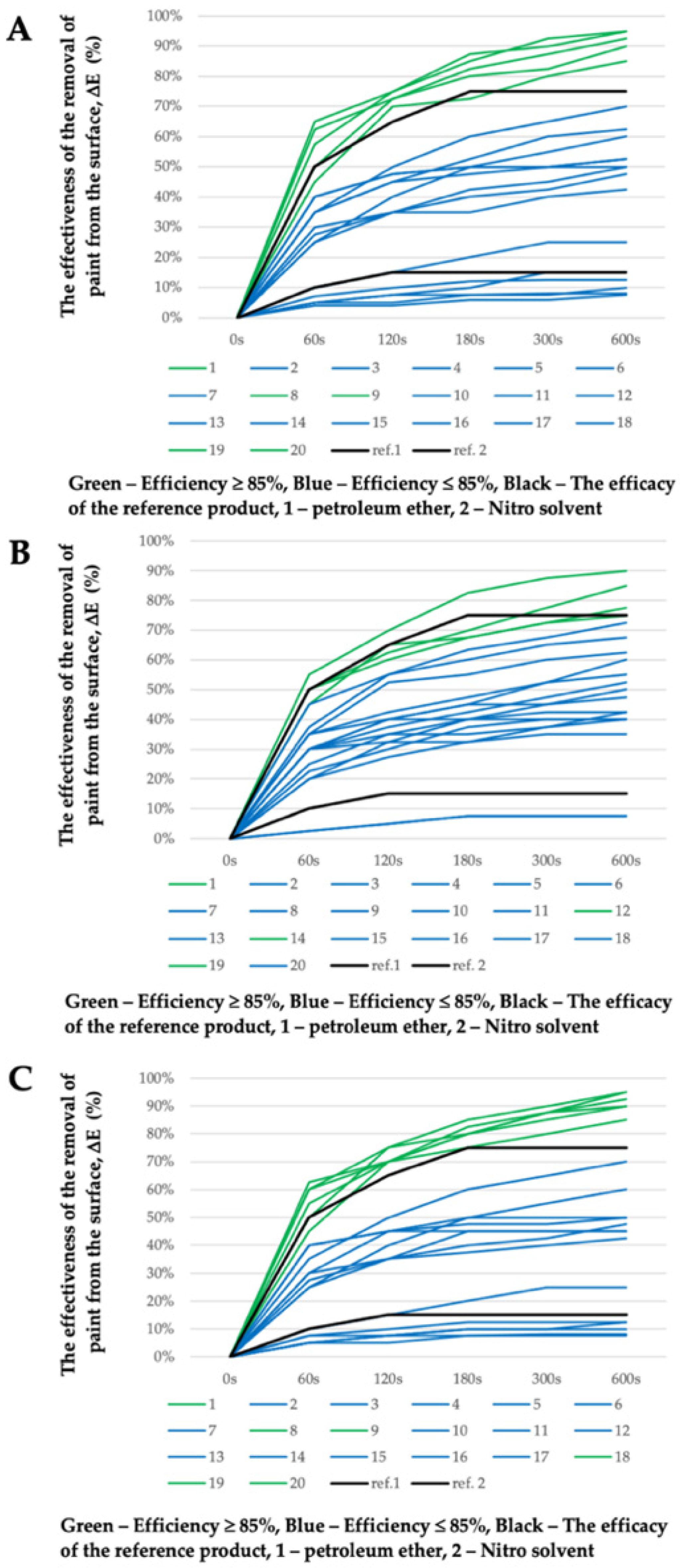

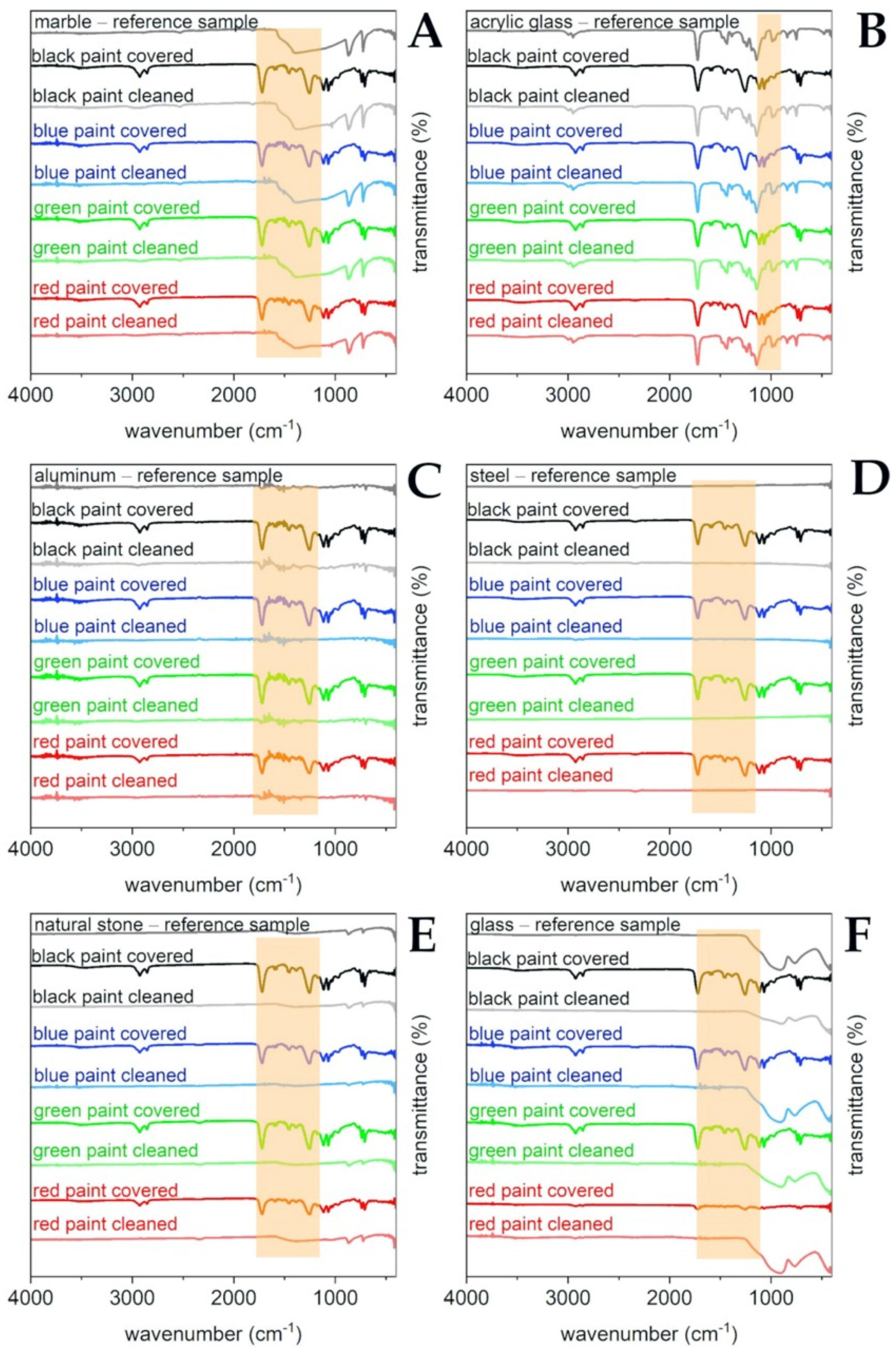
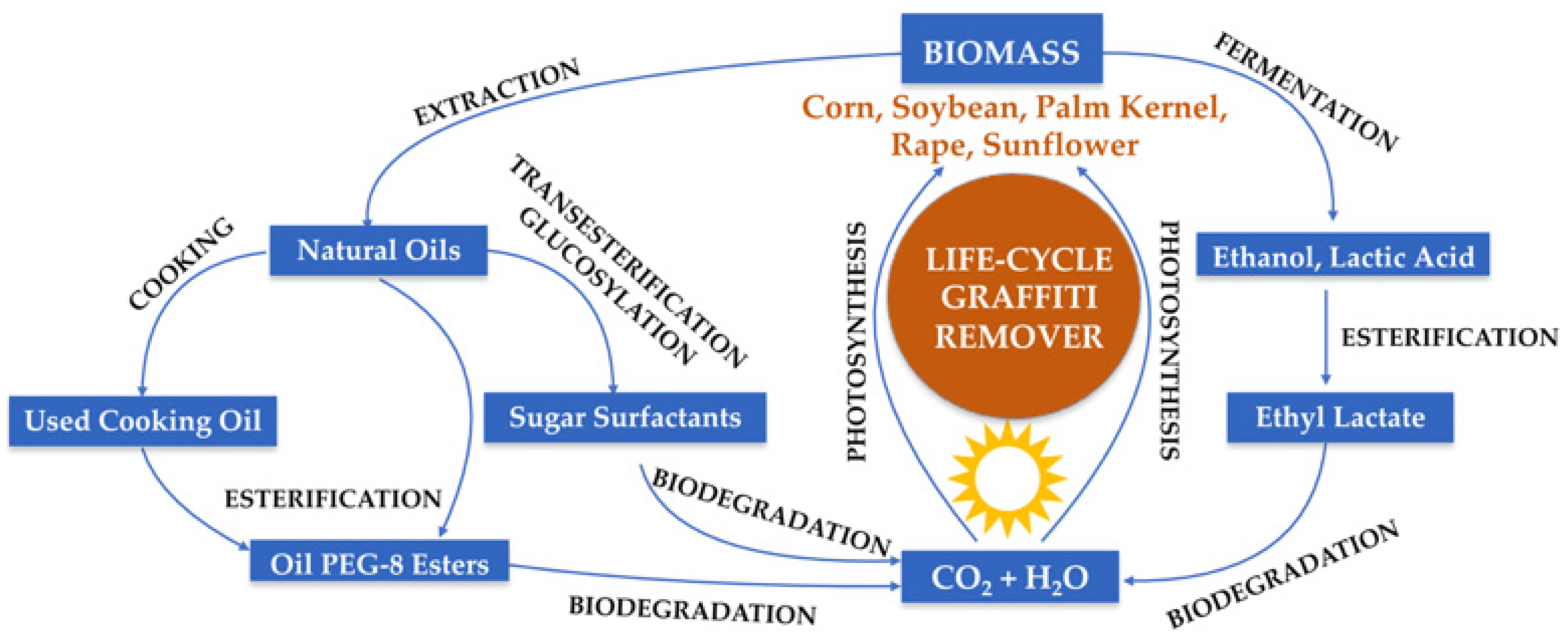
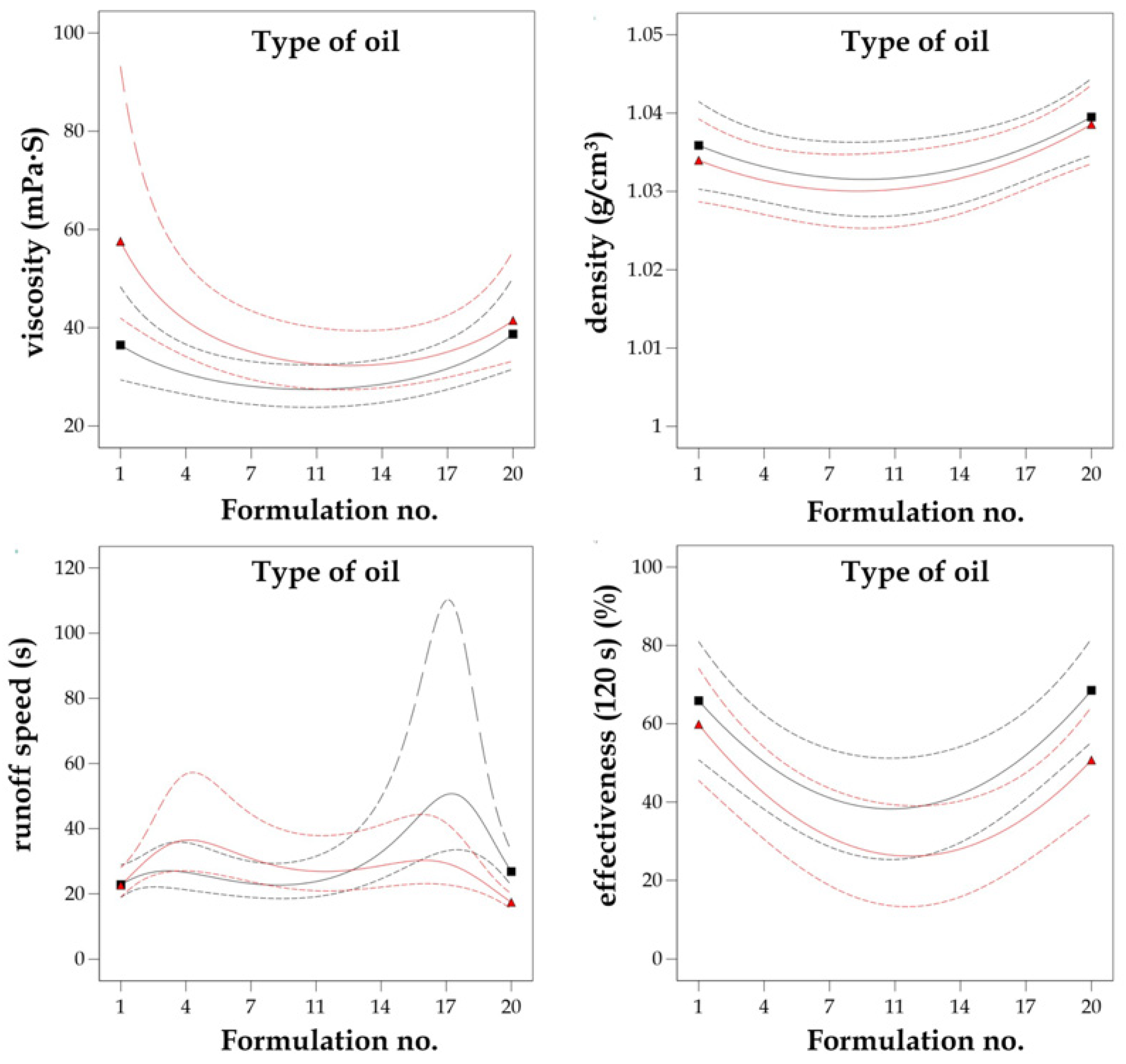
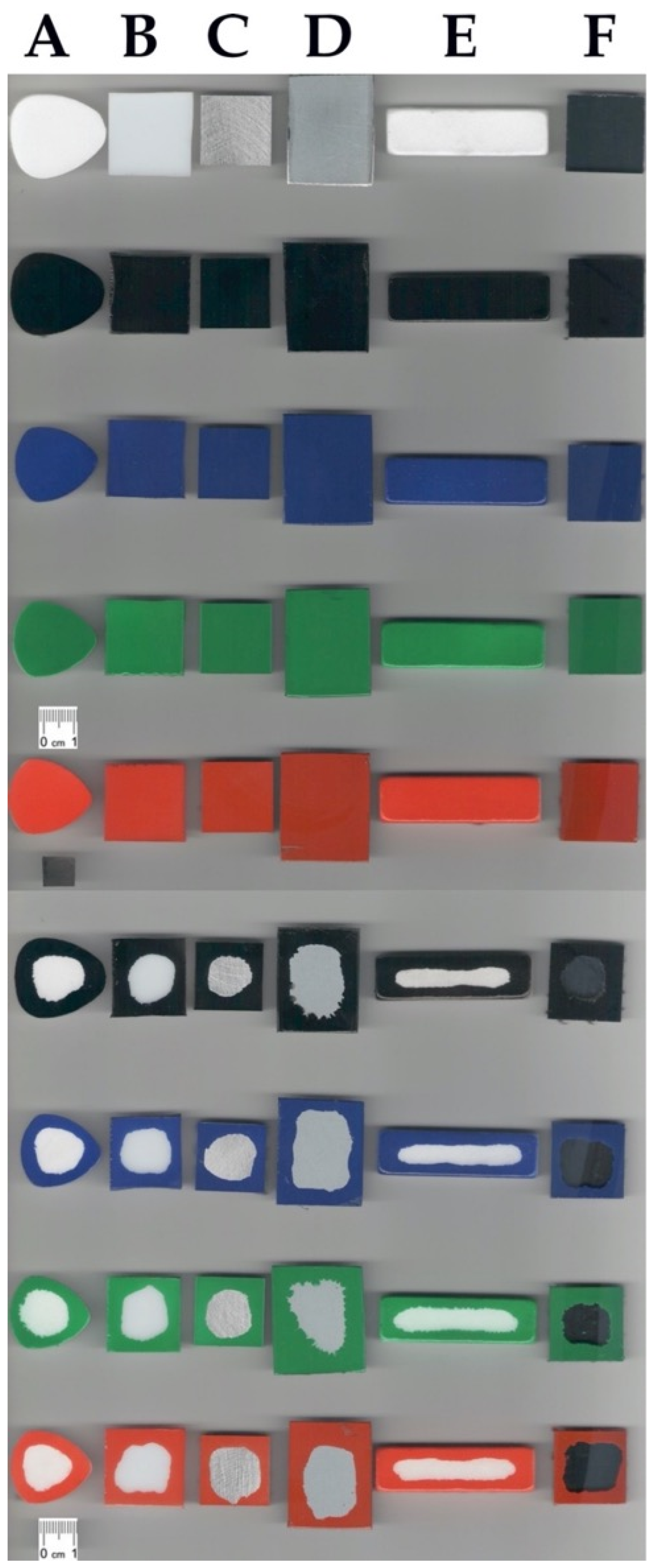
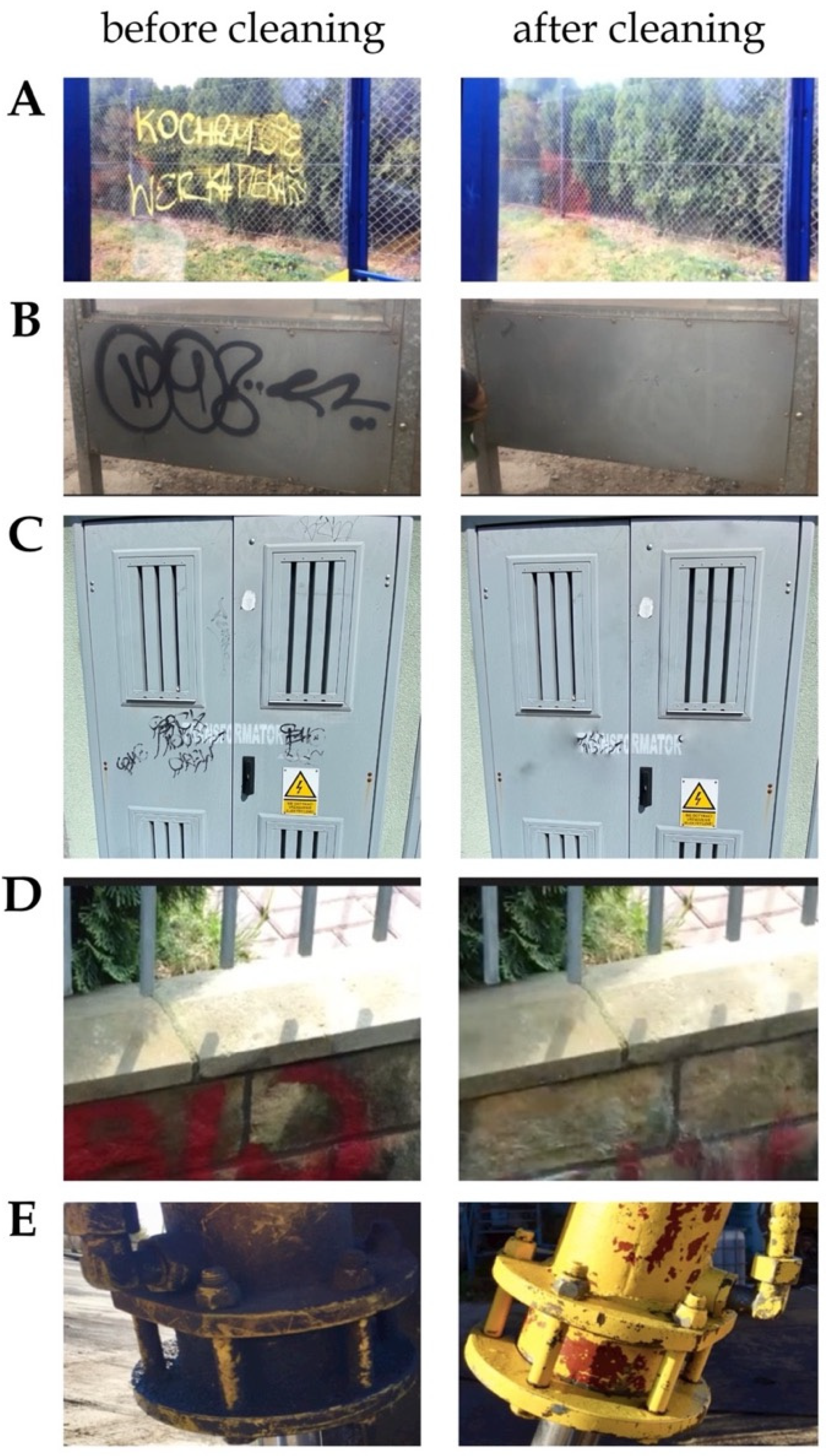
| Samples Abbreviation | MG-400-RO | MG-400-SO | MG-400-UCO |
|---|---|---|---|
| type of oil | Rapeseed oil | Sunflower oil | Used cooking oil |
| % free fatty acid (% w/w) | 1.02 | 0.51 | 1.78 |
| % oil yield (% w/w) | 98.98 | 99.49 | 98.22 |
| feed molar ratio (oil: PEG-8) | 1:1.2 | 1:1.2 | 1:1.2 |
| mass oil (g) | 850 | 850 | 900 |
| mass PEG-8 (g) | 480 | 480 | 480 |
| Process Control Monitoring | |||
| Time (h) | Acid value (mg KOH/g) | ||
| 0 | 1.28 | 0.64 | 3.26 |
| 2 | 0.62 | 0.24 | 1.25 |
| 4 | 0.21 | 0.09 | 0.13 |
| 6 | 0.05 | 0.04 | 0.06 |
| 8 | 0.02 | 0.02 | 0.03 |
| Time (h) | Saponification value (mg KOH/g) | ||
| 0 | 131.02 | 123.35 | 174.78 |
| 2 | 130.40 | 123.11 | 173.53 |
| 4 | 130.19 | 123.02 | 173.40 |
| 6 | 130.14 | 122.98 | 173.34 |
| 8 | 130.12 | 122.96 | 173.31 |
| Time (h) | Hydroxyl value (mg KOH/g) | ||
| 0 | 110.21 | 114.17 | 125.41 |
| 2 | 108.34 | 112.23 | 123.28 |
| 4 | 107.57 | 111.44 | 122.12 |
| 6 | 106.84 | 110.68 | 121.29 |
| 8 | 106.72 | 110.54 | 121.54 |
| Time (h) | Water content (% w/w) | ||
| 0 | 0.213 | 0.127 | 0.371 |
| 2 | 0.015 | 0.015 | 0.016 |
| 4 | 0.012 | 0.011 | 0.012 |
| 6 | 0.010 | 0.010 | 0.010 |
| 8 | 0.009 | 0.008 | 0.009 |
| Samples Abbreviation | MG-400-RO | MG-400-SO | MG-400-UCO |
|---|---|---|---|
| Type of oil | Rapeseed oil | Sunflower oil | Used cooking oil |
| Physical state at 25 °C | Yellowish transparent liquid | Yellowish transparent liquid | Brownish transparent liquid |
| % free fatty acid (% w/w) | <0.01 | <0.01 | <0.01 |
| Mn, (M) | 645 | 640 | 550 |
| Acid value (mg KOH/g) | <0.01 | <0.01 | <0.01 |
| Saponification value (mg KOH/g) | 130.15 | 122.92 | 173.25 |
| Hydroxyl value (mg KOH/g) | 106.71 | 110.50 | 121.51 |
| Water content (% w/w) | <0.01 | <0.01 | <0.01 |
| Density (g/cm3) (25 °C) | 1.1321 | 1.1442 | 1.1332 |
| Viscosity (mPa·s) (25 °C) | 97.42 | 105.42 | 98.36 |
| Controlled Variables of the Composition | Functional Characteristics | ||||||
|---|---|---|---|---|---|---|---|
| Formulation 1 (Symbols) | MG-400-RO (%w/w) | EL (%w/w) | APG (%w/w) | W (%w/w) | Viscosity (mPa·s) | Density (g/cm3) | Appearance |
| MG-400-RO-1 | 38.50% | 30.00% | 2.50% | 29.00% | 40.76 | 1.0345 | 1 |
| MG-400-RO-2 | 29.00% | 30.00% | 2.50% | 38.50% | 24.76 | 1.0362 | 3 |
| MG-400-RO-3 | 48.50% | 30.00% | 2.50% | 19.00% | 40.59 | 1.0402 | 1 |
| MG-400-RO-4 | 42.50% | 22.50% | 2.50% | 32.50% | 26.35 | 1.0331 | 1 |
| MG-400-RO-5 | 38.50% | 20.00% | 2.50% | 39.00% | 29.39 | 1.0323 | 1 |
| MG-400-RO-6 | 38.50% | 10.00% | 2.50% | 49.00% | 18.74 | 1.0251 | 4 |
| MG-400-RO-7 | 28.50% | 30.00% | 2.50% | 39.00% | 21.36 | 1.0387 | 2 |
| MG-400-RO-8 | 28.50% | 40.00% | 2.50% | 29.00% | 30.07 | 1.0451 | 2 |
| MG-400-RO-9 | 43.50% | 30.00% | 2.50% | 24.00% | 41.96 | 1.0395 | 1 |
| MG-400-RO-10 | 54.80% | 42.70% | 2.50% | 0.00% | 54.84 | 1.0380 | 2 |
| MG-400-RO-11 | 25.00% | 30.00% | 2.50% | 42.50% | 20.20 | 1.0285 | 3 |
| MG-400-RO-12 | 20.00% | 30.00% | 2.50% | 47.50% | 19.45 | 1.0273 | 3 |
| MG-400-RO-13 | 57.50% | 30.00% | 2.50% | 10.00% | 41.15 | 1.0380 | 1 |
| MG-400-RO-14 | 62.50% | 30.00% | 2.50% | 5.00% | 41.1 | 1.0401 | 1 |
| MG-400-RO-15 | 38.50% | 25.00% | 2.50% | 34.00% | 36.42 | 1.0297 | 1 |
| MG-400-RO-16 | 38.50% | 15.00% | 2.50% | 44.00% | 18.54 | 1.0224 | 4 |
| MG-400-RO-17 | 38.50% | 5.00% | 2.50% | 54.00% | 20.21 | 1.0148 | 4 |
| MG-400-RO-18 | 38.50% | 35.00% | 2.50% | 24.00% | 29.31 | 1.0363 | 1 |
| MG-400-RO-19 | 38.50% | 40.00% | 2.50% | 19.00% | 28.74 | 1.0395 | 1 |
| MG-400-RO-20 | 38.50% | 45.00% | 2.50% | 14.00% | 27.75 | 1.0420 | 1 |
| Formulation 2 (Symbols) | MG-400-SO (%w/w) | EL (%w/w) | APG (%w/w) | W (%w/w) | Viscosity (mPa·s) | Density (g/cm3) | Appearance |
| MG-400-SO-1 | 32.50% | 50.00% | 2.50% | 15.00% | 25.18 | 1.0345 | 2 |
| MG-400-SO-2 | 47.50% | 40.00% | 2.50% | 10.00% | 32.71 | 1.0362 | 2 |
| MG-400-SO-3 | 48.50% | 30.00% | 2.50% | 19.00% | 53.13 | 1.0331 | 2 |
| MG-400-SO-4 | 42.50% | 22.50% | 2.50% | 32.50% | 45.99 | 1.0261 | 0 |
| MG-400-SO-5 | 38.50% | 20.00% | 2.50% | 39.00% | 36.15 | 1.0253 | 0 |
| MG-400-SO-6 | 38.50% | 10.00% | 2.50% | 49.00% | 24.01 | 1.0181 | 3 |
| MG-400-SO-7 | 28.50% | 30.00% | 2.50% | 39.00% | 25.97 | 1.0316 | 0 |
| MG-400-SO-8 | 28.50% | 40.00% | 2.50% | 29.00% | 25.22 | 1.0380 | 0 |
| MG-400-SO-9 | 43.50% | 30.00% | 2.50% | 24.00% | 54.10 | 1.0324 | 0 |
| MG-400-SO-10 | 54.80% | 42.70% | 2.50% | 0.00% | 64.67 | 1.0421 | 2 |
| MG-400-SO-11 | 46.00% | 30.00% | 2.50% | 21.50% | 53.68 | 1.0300 | 1 |
| MG-400-SO-12 | 22.50% | 30.00% | 2.50% | 45.00% | 25.86 | 1.0258 | 0 |
| MG-400-SO-13 | 51.00% | 30.00% | 2.50% | 16.50% | 53.02 | 1.0311 | 2 |
| MG-400-SO-14 | 40.00% | 40.00% | 2.50% | 17.50% | 49.55 | 1.0363 | 1 |
| MG-400-SO-15 | 21.00% | 40.00% | 2.50% | 36.50% | 26.15 | 1.0326 | 0 |
| MG-400-SO-16 | 38.50% | 15.00% | 2.50% | 44.00% | 30.1 | 1.0182 | 3 |
| MG-400-SO-17 | 38.50% | 25.00% | 2.50% | 34.00% | 45.32 | 1.0251 | 0 |
| MG-400-SO-18 | 38.50% | 30.00% | 2.50% | 29.00% | 54.45 | 1.0284 | 0 |
| MG-400-SO-19 | 37.50% | 50.00% | 2.50% | 10.00% | 26.42 | 1.0423 | 2 |
| MG-400-SO-20 | 27.50% | 50.00% | 2.50% | 20.00% | 24.32 | 1.0409 | 2 |
| Formulation 3 (Symbols) | MG-400-UCO (%w/w) | EL (%w/w) | APG (%w/w) | W (%w/w) | Viscosity (mPa·s) | Density (g/cm3) | Appearance |
| MG-400-UCO-1 | 38.50% | 30.00% | 2.50% | 29.00% | 46.32 | 1.0259 | 1 |
| MG-400-UCO-2 | 29.00% | 30.00% | 2.50% | 38.50% | 27.51 | 1.0242 | 3 |
| MG-400-UCO-3 | 48.50% | 30.00% | 2.50% | 19.00% | 47.75 | 1.0261 | 1 |
| MG-400-UCO-4 | 42.90% | 22.29% | 2.50% | 32.32% | 41.78 | 1.0191 | 1 |
| MG-400-UCO-5 | 38.50% | 20.00% | 2.50% | 39.00% | 32.65 | 1.0183 | 1 |
| MG-400-UCO-6 | 38.50% | 10.00% | 2.50% | 49.00% | 21.54 | 1.0112 | 4 |
| MG-400-UCO-7 | 28.50% | 30.00% | 2.50% | 39.00% | 23.47 | 1.0246 | 2 |
| MG-400-UCO-8 | 28.50% | 40.00% | 2.50% | 29.00% | 32.69 | 1.0309 | 2 |
| MG-400-UCO-9 | 43.50% | 30.00% | 2.50% | 24.00% | 48.82 | 1.0254 | 1 |
| MG-400-UCO-10 | 54.80% | 42.70% | 2.50% | 0.00% | 58.34 | 1.0350 | 2 |
| MG-400-UCO-11 | 25.00% | 30.00% | 2.50% | 42.50% | 23.11 | 1.0235 | 3 |
| MG-400-UCO-12 | 20.00% | 30.00% | 2.50% | 47.50% | 22.47 | 1.0230 | 3 |
| MG-400-UCO-13 | 57.50% | 30.00% | 2.50% | 10.00% | 47.29 | 1.0268 | 1 |
| MG-400-UCO-14 | 62.50% | 30.00% | 2.50% | 5.00% | 47.18 | 1.0273 | 1 |
| MG-400-UCO-15 | 38.50% | 25.00% | 2.50% | 34.00% | 40.21 | 1.0200 | 1 |
| MG-400-UCO-16 | 38.50% | 15.00% | 2.50% | 44.00% | 20.87 | 1.0190 | 4 |
| MG-400-UCO-17 | 38.50% | 5.00% | 2.50% | 54.00% | 24.31 | 1.0054 | 4 |
| MG-400-UCO-18 | 38.50% | 35.00% | 2.50% | 24.00% | 33.45 | 1.0276 | 1 |
| MG-400-UCO-19 | 38.50% | 40.00% | 2.50% | 19.00% | 31.79 | 1.0315 | 1 |
| MG-400-UCO-20 | 38.50% | 45.00% | 2.50% | 14.00% | 29.53 | 1.0356 | 1 |
| No. | Formulation Number a | Type of Oil | Viscosity (mPa∙s) | Density (g/cm3) | Runoff Speed (s) | Effectiveness (%) | Desirability | ||||
|---|---|---|---|---|---|---|---|---|---|---|---|
| P b | A c | P | A | P | A | P | A | ||||
| 1 | MG-400-RO-20 | RO | 38.7 | 37.8 | 1.04 | 1.04 | 26.8 | 26.0 | 68.5 | 75.0 | 0.907 |
| 2 | MG-400-RO-1 | RO | 36.5 | 33.8 | 1.04 | 1.04 | 22.8 | 21.0 | 65.9 | 72.5 | 0.870 |
| 3 | MG-400-UCO-1 | UCO | 45.7 | 36.3 | 1.03 | 1.03 | 23.4 | 20.0 | 63.3 | 75.0 | 0.833 |
| 4 | MG-400-UCO-20 | UCO | 41.0 | 45.5 | 1.03 | 1.04 | 25.9 | 24.0 | 60.1 | 70.0 | 0.786 |
| 5 | MG-400-SO-1 | SO | 57.6 | 48.2 | 1.03 | 1.03 | 22.6 | 20.0 | 59.9 | 65.0 | 0.784 |
| 6 | MG-400-SO-20 | SO | 41.5 | 44.3 | 1.04 | 1.04 | 17.3 | 17.0 | 50.7 | 42.5 | 0.653 |
Publisher’s Note: MDPI stays neutral with regard to jurisdictional claims in published maps and institutional affiliations. |
© 2021 by the authors. Licensee MDPI, Basel, Switzerland. This article is an open access article distributed under the terms and conditions of the Creative Commons Attribution (CC BY) license (https://creativecommons.org/licenses/by/4.0/).
Share and Cite
Bartman, M.; Balicki, S.; Wilk, K.A. Formulation of Environmentally Safe Graffiti Remover Containing Esterified Plant Oils and Sugar Surfactant. Molecules 2021, 26, 4706. https://doi.org/10.3390/molecules26154706
Bartman M, Balicki S, Wilk KA. Formulation of Environmentally Safe Graffiti Remover Containing Esterified Plant Oils and Sugar Surfactant. Molecules. 2021; 26(15):4706. https://doi.org/10.3390/molecules26154706
Chicago/Turabian StyleBartman, Marcin, Sebastian Balicki, and Kazimiera A. Wilk. 2021. "Formulation of Environmentally Safe Graffiti Remover Containing Esterified Plant Oils and Sugar Surfactant" Molecules 26, no. 15: 4706. https://doi.org/10.3390/molecules26154706
APA StyleBartman, M., Balicki, S., & Wilk, K. A. (2021). Formulation of Environmentally Safe Graffiti Remover Containing Esterified Plant Oils and Sugar Surfactant. Molecules, 26(15), 4706. https://doi.org/10.3390/molecules26154706







